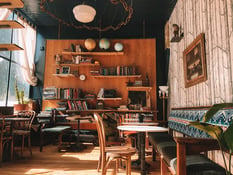There’s a hum in a busy restaurant when the back of the house and the front of the house are in harmony. Food is coming out of the kitchen on time, drinks are full, the hosts are nailing the timing, and tables are turning. The symphony of people, the smell of the food, the delicate stem of a wine glass in your hand — before you know it, everyone’s having such a good time, they’re chatting louder, and then chatting even louder to be heard over the loud chatter.
The sound compounds as diners and staff raise their voices to be heard and before you know it, guests are unhappy (this cycle is common enough to have a name: the Lombard Effect). A normal conversation clocks in at 60 to 70 decibels, a vacuum cleaner around 75. Hearing damage can occur at a sustained 85, which is roughly pre-pandemic Midtown Manhattan at rush hour. A popular restaurant can climb even higher. Measurements in some New York restaurants have reached 96 decibels, for those who enjoy a side of lawn-mower noise with their grilled branzino.
Noise in restaurants is a poorly regulated, but well-researched issue. It takes a deft touch to find that sweet spot between happy people vs. fire engine caterwauls. Musical choices and volume levels matter, but unless you are soundtracking a dining room in a coma ward, you can’t just play Enya and call it a day. Sound, like salt, is all about balance. Too little and your meal is bland; a silent dining room is the auditory equivalent of overboiled potatoes. Too much, though, and it’s all you can think about.
Like most complainers, the “too loud” camp tend to be (unironically) noisy about their displeasure. Consumer Reports found it to be diners’ top complaint. But that doesn’t account for notoriously loud restaurants being packed. For 10 years the Spotted Pig was loud enough to cause hearing damage, but had two-hour waits.
Which brings us the importance of the hierarchy of sounds. Restaurants on busy strips around the world rely on the clamor of laughter to let would-be diners know this will be a meal you’ll enjoy. Music in open, beachfront restaurants seduce guests with their energy. A bus bin crashing to the floor will silence a room, just as live musicians are expected to be loud. In its heyday, the clearest noise at wd~50 was Chef Wylie Dufresne yelling at someone from the open kitchen. People were there for the show. By contrast, Thomas Keller’s kitchens are notoriously quiet. Diners love the sounds of their own conversations, but prefer that those sounds don’t project to everyone else in the room. It’s fickle.
Whether your restaurant's vibe is raucous or intimate, you should consider some amount of noise mitigation. That doesn’t mean constant monitoring of the decibel levels during a busy service. (That said, if you read that and thought “What? Yes! I do want to monitor decibel levels,” there’s an app for that, enjoy.) Presuming your desired aesthetic is somewhere between “church confessional” and “1950s mafia movie,” you’re going to have to get creative to find an acoustic balance.
First things first: quiet the kitchen and dining room furniture
Your kitchen is bound to make noise, but you can at least physically isolate the yowls of dishwashers, ice machines, and blenders by clever placement. The harshest sounds in a dining room are bound to be hard chairs on hard floors and utensils and dishes hitting tables. Chair sounds can be softened with felt or rubber pads, and tablecloths and placemats to dampen the clatter of eating. You’ll find this is a running theme here: soft surfaces, especially fabrics and multi-layered objects, disrupt echoes, cut what acoustic engineers call “reverb time,” and muffle excess noise.
Hire a restaurant sound engineer, or don't
If you are reading this it’s safe to assume you don’t have a giant budget and an audio consultant to redesign your dining room with partitions, hanging baffles, and fabric-wrapped foam decor. You may, though, have enough coin for custom acoustic dampeners. The squeaky wheels of the world have made this a multimillion-dollar industry, with options galore to fit your needs for color, size, and noise reduction. These include decorative wall installations, faux tin ceiling tiles, and actual art acoustical panels. Pre-fab will run you anywhere between $9-$25 per square foot, and custom work goes up from there. Consider it an investment, on the way to raising profits.
Use plants to cut restaurant noise
Turns out plants are useful for something after all: soaking up noise. You can place them around a loud room or go big with a living wall that will run you $500-$2000 to set up, before plants, and has the benefit of being dramatic and useful. As a general rule, sturdier plants with thicker stems and leaves (fiddle leaf figs, money trees, ficus of all sorts) offer more acoustic offsets than delicate plants. But no plants increase noise, so you can find what works best for your space, lighting and the relative greenness of your thumb. If you get enough natural light, herbs and veggies can grow in your space to clean the air, dampen noise, and eventually spruce up your red snapper special.
Wrap tables and pipes in rope
If plants aren’t your thing, or your budget needs to be stretched, classic DIY is the answer: Wrap pipes and table bases/legs in rope. You’re looking at less than $200 for a good-sized restaurant, though you can also add a layer of foam beneath the rope to make it even better. If you have exposed heat pipes, the binding also protects your guests, or more likely, your staff, from accidentally touching (read: burning themselves on) a hot pipe. Remember to use cotton ropes on anything that gets hot.
Sneak studio foam into your dining room
A sleek design has no room for ropes and other DIY sound reducers. Depending on the size and shape of your tables, chairs, and bar area, you may be able to trim basic studio foam to fit the undersides of chairs, barstools, and tables to absorb a good deal of noise, at maybe $3 per square foot. This tried-and-true trick can be adapted to any “hidden spaces,” such as behind art or mirrors. Just remember that foam degrades over time, so it’s not ideal for anywhere that will be above food.
Use fabrics, curtains, and upholstery to soften noise
Dampen noise by adding upholstery to chairs, barstools, and booths, or by adding thick window treatments. High-backed booths keep sounds from traveling from one table to another, so people feel their own space is intimate, even in a buzzy dining room. You probably don’t want carpet under the tables, but softer surfaces can help in high-traffic, low-food areas.
Control the dining room noise level from your phone
Your phone, to the rescue again, with the latest restaurant technologies. Most modern sound systems are Bluetooth-enabled, with optional apps. Even Spotify offers phone control of music playing through a different device. Song, volume, or mood changes are done with a flick of the thumb. Gone are the days of traversing a crowded dining room to adjust the music, only to end up running food, mise-ing for dessert, bussing a table, schmoozing the investor, and having 45 minutes pass before you reach the stereo. And, honestly? Good riddance.
[Photo by Ksenia Chernaya from Pexels]





